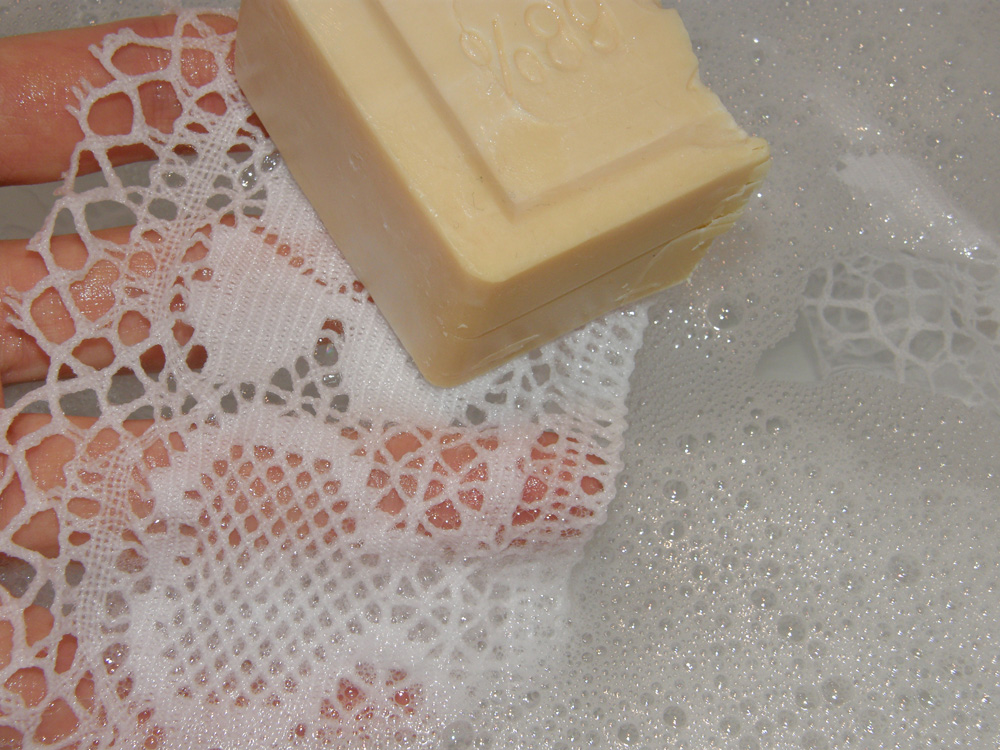How to care for bobbin lace
You need to wash the hand bobbin lace collar and the bed linen with machine bobbin lace. Can you put everything in the washing machine? Is there a difference? Of course there is. Each material and design wants its own. And to keep clothes and home textiles in good condition, we must first find out what the lace is made of and what the recommended symbols for the maintenance and care of textiles mean.


We should take time and care of the delicate lace we care about, washing it gently in our hands. This is the only way to ensure maximum stability in shape and colour. We recommend using traditional natural soaps, eco-friendly detergents and starches.
When washing lace in the washing machine, use a short programme for delicate linen and a protective net, do not mix different colours together and do not fill the washing machine full, so that the lace does not wrinkle as much. Follow the care symbols provided by the manufacturer who recommends the appropriate care for the specific product.
In short, a delicate hand-beaded collar definitely does not belong in the washing machine, whereas cotton or linen bed linen and tablecloths decorated with machine bobbin lace can be washed in the washing machine without any worries, as long as certain rules, temperature etc. are followed.
Laundry
Although natural materials can withstand high temperatures, we recommend washing at 30-40 °C. Do not wring the lace at all, or set the wringing speed to the lowest setting.
Drying
Ideally, lace should be dried in the fresh air hanging or unfolded and shaped to the desired form on a mat. We do not recommend tumble dryers, as the fabric will wear and shrink more in them.
Ironing
Iron lace that is still slightly damp gently and carefully so as not to break the lace pattern with the iron tip. We can use the experience of our grandmothers, who ironed delicate fabrics over a clean, damp cloth such as a handkerchief or towel. Cotton and linen lace are not so bothered by higher temperatures, but beware of synthetic materials (PES, acrylic) which can be irreversibly deformed and burnt by too hot an iron.
TIPS:
First washing of linen
You can soak linen lace in lukewarm water with a little vinegar before washing it for the first time. The vinegar will fix the colour shade and the coloured lace will not fade as much. Linen is initially stiffer, but with washing it will soften over time and become more pliable and comfortable. Do not add fabric softener to the soak, linen has its characteristic natural scent. Do not bleach or starch linen lace.
What about stains?
If there are stains on the lace, it is best to remove them immediately or before washing, a layer of salt and lemon helps with red wine stains as a first aid, and warm milk cleans dried stains. Lemon juice and warm milk can also be used for tea stains. Milk even works for accidents with chocolate and cocoa. But the sooner we clean the stain, the better.
A chance for dingy and vintage lace
Pour about 3 litres of water into a suitable container and put 2 magnesium tablets (magnesium from the chemist or grocery store), soak the lace for about 10 minutes, then rinse it in clean water and leave to dry. This procedure should prolong the life of older and more tired lace.
If you have truly antique lace in your home, extreme caution is advised. Clean such treasures with a solution of sodium lauryl sulphate (4 litres of hot water + 1 teaspoon of this substance with a neutral pH). Leave the lace to soak without moving for about an hour, rinse it with great care with warm water and repeat the process until the bath is clean. Air dry the lace spread out.
OUR GRANDMOTHERS' ADVICE:
Afraid to wash very delicate lace?
Put them between two clean, wet towels and iron them. The dirt will be removed.
Black lace is no longer black?
Wash them in sweetened black coffee.
To make white white...
After washing white lace, bathe it in milk and iron it while still wet. They'll be beautifully white and stiff.
Flour instead of washing?
You can try cleaning delicate lace with flour. Sprinkle them several times and wash them gently, turning them in a bowl with flour, which will bind the dust and dirt.
 Česky
Česky Slovensky
Slovensky English
English
